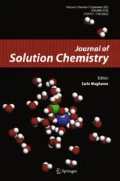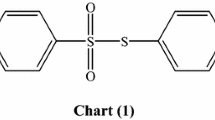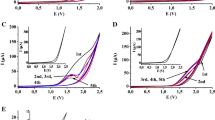Abstract
The reduction of benzophenone (Bzph) in 3-pentanone (PEN), acetone (ACE), N,N-dimethylacetamide (DMA), N,N-dimethylformamide (DMF), tetrahydrofuran (THF), acetonitrile (ACN) and dimethyl sulfoxide (DMSO) with n-tetrabutylammonium hexafluorophosphate (TBAPF6) as background electrolyte was studied using the technique of cyclic voltammetry at the temperature of 263.15 K. The half-wave potentials (E 1/2) were extracted. The reduction of Bzph occurs in two successive one-electron steps to produce first the free radical anion Bzph− and then the dianion Bzph2−. The results indicated that the radical anion Bzph− is reoxidized to Bzph in all investigated solvent media whereas the dianion Bzph2− is reoxidized to Bzph− only in THF. The heterogeneous electron-transfer rate constants (k s ) were evaluated by employing the electrochemical rate equation proposed by Nicholson. The rate of electron transfer for the Bzph/Bzph− couple was found to be relatively slow in all investigated solvent media. Consequently, the electron-transfer processes can be recognized as quasi-reversible. The diffusion coefficients (D) of Bzph in the investigated solvent media have been calculated using the modified Randles-Sevcik equation. The effect of the physical and chemical properties of the solvent medium on the electrochemical behavior of Bzph has been examined.
Similar content being viewed by others
References
Schlenk, W., Weickel, T.: Metallic compounds of diaryl ketones. Chem. Berichte 44, 1182–1189 (1911)
Kleiner, G., Tarnopolsky, A., Hoz, S.: Reduction of benzophenone by SmI2: The role of proton donors in determining product distribution. Org. Lett. 7, 4197–4200 (2005)
Simon, J.D., Peters, K.S.: Solvent effects on the picosecond dynamics of the photoreduction of benzophenone by aromatic amines. J. Am. Chem. Soc. 103, 6403–6406 (1981)
Given, P.H., Peover, M.E.: Polarographic reduction of aromatic hydrocarbons and carbonyl compounds in dimethylformamide in the presence of proton donors. J. Chem. Soc., 385–393 (1960)
Wawzonek, S., Gundersen, A.: Polarographic studies in acetonitrile and dimethylformamide. Behavior of aromatic ketones and aldehydes. J. Electrochem. Soc. 107, 537–540 (1960)
Michielli, R.F., Elving, P.J.: Electrochemical reduction of benzophenone in aprotic medium. Effect of proton availability. J. Am. Chem. Soc. 90, 1989–1995 (1968)
Curphey, T.J., Trivedi, L.D., Layloff, T.: Electrochemical reductive acylation of benzophenone. J. Org. Chem. 39, 3831–3834 (1974)
Demortier, A., Bard, A.J.: Electrochemical reactions of organic compounds in liquid ammonia. Reduction of benzophenone. J. Am. Chem. Soc. 95, 3495–3500 (1973)
Nadjo, L., Savéant, J.M.: Electrochemical reduction of substituted benzophenones and fluorenones in media of low proton availability mechanism of the reductive cleavage of bromo and chlorobenzophenones. Electroanal. Chem. Interface Electrochem. 30, 41–57 (1971)
Grimshaw, J., Hamilton, R.: Steric and electronic effects on the redox potentials of benzophenone radical anions. J. Electroanal. Chem. 106, 339–346 (1980)
Zuman, P., Exner, O., Rekker, R.F., Nauta, W.T.: Polarographic reduction of aldehydes and ketones. Linear free energy treatment of substituted benzophenones. Collect. Czech. Chem. Commun. 33, 3213–3226 (1968)
Molander, G.A., Harris, C.R.: Sequencing reactions with samarium(II) iodide. Chem. Rev. 96, 307–338 (1996)
Kagan, H.B.: Twenty-five years of organic chemistry with diiodosamarium: an overview. Tetrahedron 59, 1–10372 (1035) (2003)
Elving, P.J., Leone, J.T.: Mechanism of the electrochemical reduction of phenyl ketones. J. Am. Chem. Soc. 80, 1021–1029 (1958)
Suzuki, M., Elving, P.J.: Kinetics and mechanism for the electrochemical reduction of benzophenone in acidic media. J. Phys. Chem. 65, 391–398 (1961)
Geske, D.H., Maki, A.H.: Electrochemical generation of free radicals and their study by electron spin resonance spectroscopy: The nitrobenzene anion radical. J. Am. Chem. Soc. 82, 2671–2676 (1960)
Kemula, W., Grabowski, Z.R., Kalinowski, M.K.: Electrochemical method of studying the reactions of free radicals. Naturwissenschaften 47, 514–514 (1960)
Kadish, K.M., Cornillon, J.L., Yao, C.L., Malinski, T., Gritzner, G.: Solvent effects on electrode potentials of metalloporphyrins. Reduction of 5,10,15,20-tetraphenylporphinato complexes in non-aqueous media. J. Electroanal. Chem. 235, 189–207 (1987)
Hecht, M., Fawcett, W.R.: Solvent effects in the electroreduction of [diamine-N,N′-polycarboxylato]chromate(III) complexes at a mercury electrode. J. Electroanal. Chem. 396, 473–483 (1995)
Lorenzana, T., Franjo, C., Jiménez, E., Fernández, J., Paz-Andrade, M.I.: Volume excess of binary mixtures containing 3-pentanone or 3-heptanone with 1-chloroalkanes at 298.15 K. J. Chem. Eng. Data 39, 172–174 (1994)
Wang, J., Zhu, A., Zhao, Y., Zhuo, K.: Excess molar volumes and excess logarithm viscosities for binary mixtures of the ionic liquid 1-butyl-3-methylimidazolium hexaflurophosphate with some organic compounds. J. Solution Chem. 34, 585–596 (2005)
Johari, G.P.: Dielectric constants, densities, and viscosities of acetone-1-propanol and acetone-n-hexane mixtures at 25 °C. J. Chem. Eng. Data 13, 541–543 (1968)
Iloukhani, H., Khanlarzadeh, K.: Densities, viscosities, and refractive indices for binary and ternary mixtures of N,N-dimethylacetamide/2-methylbutan-2-ol/ethyl acetate at 298.15 K for the liquid region and at ambient pressure. J. Chem. Eng. Data 51, 1226–1231 (2006)
Nikam, P.S., Kharat, S.J.: Densities and viscosities of binary mixtures of N,N-dimethylformamide with benzyl alcohol and acetophenone at 298.15, 303.15, 308.15 and 313.15 K. J. Chem. Eng. Data 48, 1291–1295 (2003)
Paez, S., Confreras, M.: Densities and viscosities of binary mixtures of 1-propanol and 2-propanol with acetonitrile. J. Chem. Eng. Data 34, 455–459 (1989)
Giner, B., Gascon, I., Villares, A., Cea, P., Lafuente, C.: Densities and viscosities of the binary mixtures of tetrahydrofuran with isomeric chlorobutanes at 298.15 K and 313.15 K. J. Chem. Eng. Data 51, 1321–1325 (2006)
Baragi, J.G., Aralaguppi, M.I., Aminabhavi, T.M., Kariduraganavar, M.Y., Kittur, A.S.: Density, viscosity, refractive index, and speed of sound for binary mixtures of anisole with 2-chloroethanol, 1,4-dioxane, tetrachloroethylene, tetrachloroethane, DMF, DMSO, and diethyl oxalate at 298.15, 303.15 and 308.15 K. J. Chem. Eng. Data 50, 910–916 (2005)
Tsierkezos, N.G., Molinou, I.E.: Thermodynamic properties of water/ethylene glycol at 283.15, 293.15, 303.15, and 313.15 K. J. Chem. Eng. Data 43, 989–993 (1998)
Tsierkezos, N.G., Molinou, I.E.: Surface tension of the 4-methyl-2-pentanone/ethyl benzoate binary system in the temperature range from 278.15 to 308.15 K. J. Solution Chem. 35, 279–296 (2006)
Dombrowski, G.W., Dinnocenzo, J.P., Farid, S., Goodman, J.L., Gould, I.R.: a-C-H bond dissociation energies of some tertiary amines. J. Org. Chem. 64, 427–431 (1999)
Hartl, F., Mahabiersing, T., Le Floch, P., Mathey, F., Ricard, L., Rosa, P., Záliš, S.: Electronic properties of 4,4′,5,5′-tetramethyl-2,2′-biphosphinine (tmbp) in the redox series fac-[Mn(Br)(CO)3(tmbp)], [Mn(CO)3(tmbp)]2, and [Mn(CO)3(tmbp)]−: Crystallographic, spectroelectrochemical, and DFT computational study. Inorg. Chem. 42, 4442–4455 (2003)
Hultgren, V.M., Mariotti, A.W.A., Bond, A.M., Wedd, A.G.: Reference potential calibration and voltammetry at macrodisk electrodes of metallocene derivatives in the ionic liquid [bmim][PF6]. Anal. Chem. 74, 3151–3156 (2002)
Gosser, D.K.: Cyclic Voltammetry, p. 30. VCH, New York (1993)
Degrand, C.D., Prest, R., Compagnon, P.L.: Electrochemical synthesis of (phenylseleno)benzophenones and (phenyltelluro)benzophenones by the SRN1 mechanism using a redox catalyst. J. Org. Chem. 52, 5229–5233 (1987)
Bond, A.M., Oldham, K.B., Snook, G.A.: Use of the eerrocene oxidation process to provide both reference electrode potential calibration and a simple measurement (via Semiintegration) of the uncompensated resistance in cyclic voltammetric studies in high-resistance organic solvents. Anal. Chem. 72, 3492–3496 (2000)
Gutmann, V.: The Donor-Acceptor Approach to Molecular Interactions. Plenum, New York (1978)
Gritzner, G., Danksagmüller, K., Gutmann, V.: Solvent effects on the redox potentials of tetraethylammonium hexacyanomanganate(III) and hexacyanoferrate(III). J. Electroanal. Chem. 90, 203–210 (1978)
Jaworski, J.S., Lesniewska, W., Kalinowski, M.K.: Solvent effect on the redox potential of quinone-semiquinone systems. J. Electroanal. Chem. 105, 329–334 (1979)
Randles, J.E.B.: Cathode-ray polarograph, Current-voltage curves. Trans. Faraday Soc. 44, 327–338 (1948)
Comminges, C., Barhdadi, R., Laurent, M., Troupel, M.: Determination of viscosity, ionic conductivity, and diffusion coefficients in some binary systems: ionic liquids and molecular solvents. J. Chem. Eng. Data 51, 680–685 (2006)
Bard, A.J., Faulkner, L.R.: Electrochemical Methods. Wiley, New York (1980)
Maeda, Y., Sato, K., Ramaraj, R., Rao, T.N., Tryk, D.A., Fujishima, A.: The electrochemical response of highly boron-doped conductive diamond electrodes to Ce3+ ions in aqueous solution. Electrochim, Acta 44, 3441–3449 (1999)
Fawcett, W.R., Fedurco, M.: Medium effects in the electroreduction of benzophenone in aprotic solvents. J. Phys. Chem. 97, 7075–7080 (1993)
Robinson, R.A.: Stokes, R.H. Electrolyte Solutions, 2nd edn. Butterworths, London (1959)
Nicholson, R.S.: Theory and application of cyclic voltammetry for measurement of electrode reaction kinetics. Anal. Chem. 37, 1351–1355 (1965)
Author information
Authors and Affiliations
Corresponding author
Rights and permissions
About this article
Cite this article
Tsierkezos, N.G. Investigation of the Electrochemical Reduction of Benzophenone in Aprotic Solvents Using the Method of Cyclic Voltammetry. J Solution Chem 36, 1301–1310 (2007). https://doi.org/10.1007/s10953-007-9188-4
Received:
Accepted:
Published:
Issue Date:
DOI: https://doi.org/10.1007/s10953-007-9188-4




